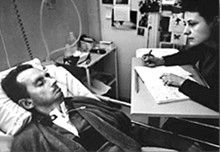Jean-Dominique Bauby facts for kids
Quick facts for kids
Jean-Dominique Bauby
|
|
|---|---|

Bauby, blinking, to Claude Mendibil, transcribing, 1996
|
|
| Born | 23 April 1952 Paris, France |
| Died | 9 March 1997 (aged 44) Berck-sur-Mer, Nord-Pas de Calais, France |
| Occupation | Journalist, editor, writer |
| Language | French |
| Notable works | The Diving Bell and the Butterfly |
| Children | 2 |
Jean-Dominique Bauby (French: [ʒɑ̃ dɔminik bobi]; 23 April 1952 – 9 March 1997) was a French journalist and writer. He was also the editor of the well-known French fashion magazine Elle. Bauby became famous for writing his memoir, The Diving Bell and the Butterfly, after a severe stroke left him almost completely paralyzed.
Life as a Journalist
Jean-Dominique Bauby was born in Paris, France. He grew up in the city, near the beautiful Tuileries Garden.
He started his career as a journalist at newspapers like Combat. Later, he became the editor-in-chief of Le Matin de Paris. He also worked for Paris Match, a popular magazine. Eventually, he joined Elle magazine and became its editor. He had two children.
Writing His Memoir
On December 8, 1995, when Bauby was 43 years old, he had a serious stroke. This happened while he was driving his son to the theater. When he woke up in the hospital about three weeks later, he could only move one part of his body: his left eyelid.
He had a rare condition called locked-in syndrome. This means his mind was still sharp and active, but most of his body was paralyzed. He couldn't move his mouth, arms, or legs. He also lost a lot of weight during this time.
Before his stroke, Bauby had agreed to write a book. Even though he couldn't speak or move, he was determined to write it. His speech therapist helped him by arranging the alphabet in order of how often letters are used. This made it easier to "speak."
A special editor named Claude Mendibil helped him. She would slowly say each letter of the alphabet. When she reached the correct letter, Bauby would blink his left eyelid. This was how he "dictated" his book, letter by letter. It took him two months to write the 130-page book, working three hours a day, every day.
The book, called The Diving Bell and the Butterfly, was published on March 7, 1997. It quickly became a huge success across Europe. Sadly, Bauby died unexpectedly from pneumonia just two days after his book was released. He was 44 years old. He is buried in the Père-Lachaise cemetery in Paris.
The Film Adaptation
After Bauby's death, his book and story gained more attention. A short documentary about him was made, showing his life in the hospital.
In 2007, a movie version of The Diving Bell and the Butterfly was released. It was directed by Julian Schnabel and starred Mathieu Amalric as Jean-Dominique Bauby. The film was highly praised by critics.
- It won the Best Director Prize at the Cannes Film Festival.
- It received Golden Globe Awards for Best Foreign Language Film and Best Director.
- It was nominated for four Academy Awards.
Some of Bauby's close friends felt the movie changed some facts about his personal life. They believed it didn't show his later partner, Florence Ben Sadoun, accurately. However, Bauby's own memoir mentions her frequent visits.
See also
 In Spanish: Jean-Dominique Bauby para niños
In Spanish: Jean-Dominique Bauby para niños

